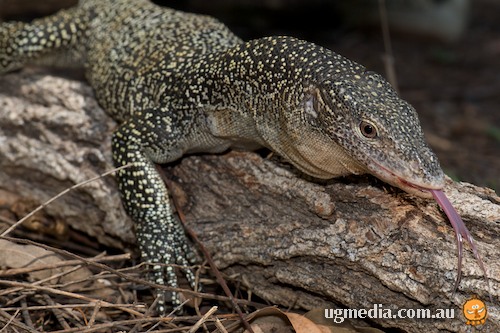Post by Ceratodromeus on Jan 15, 2016 9:17:03 GMT 5

Scientific classification
Kingdom: Animalia
Phylum: Chordata
Subphylum: Vertebrata
Class: Sauropsida
Order: Squamata
Suborder: Lacertilia
Family: Varanidae
Genus: Varanus
Subgenus: (Euprepiosaurus)
Species: V. indicus
Description
Like other members of the Euprepiosaurus subgenus,mangrove monitors are a mid sized, relatively lean species. Body coloration is typically a dark brown or black with light yellow speckling. The tail is long and laterally compressed, which aids in aquatic locomotion in the environment the mangrove monitor is found in. This species is rather variable in body size, throughout its geographic distribution,with animals in New Guinae growing to roughly 34cm (13.3in)in snout-ventral length, in Guam attaining snout-ventral lengths of up to 58cm(22.8in),and animals in Northern Australia attaining total body lengths up[ to 100cm(39.3in); the longest recorded mangrove monitor was approximately 1.24m(4.06ft) in total body length; the highest recorded mass was roughly 1.9kg(4.1lbs){1} Studies conducted in 2011 show that females of similar body sizes to males tend to have smaller chest and forelimb widths{2}.

Geographic range
The species is endemic to a small portion of Northern Australia, but is also found on Guam, the Marshall, Caroline, and solomon islands. Their rangee extends to Timor as well. They are theorized to have been introduced to the Mariana islands by Japanese and/ or German sailors around the time of World War 1{3}. As the common name may imply, these varanids are fond of mangrove swamps and can commonly be found near bodies of water. However this is not the rule, as they have been found far from bodies of water.

Dietary habits
Like most other varanid species, the Mangrove monitor is a dietary generalist, taking an array of invertebrates and vertebrates; snails, shrews, crabs, rats, and earthworms are the most common prey taken by V. indicus in Guam. reptile eggs( conspecific and crocodile eggs) and lizards, namely skinks, are eaten as well{4}. Occasionally coconut crabs have been taken, as well as snakes.

Reproduction
Not many studies have been conducted investigating the reproduction of V. indicus, though one particular study conducted in the late 1980's on Guam have shown that mating occurs in the dry season there. Males are larger once they attain sexual maturity by a significant amount (mean mass of sexually mature males is approximately 1.2kg v 487g in females){1,5}. Clutch size is theorized to be around ten eggs; young mangrove monitors can be found year round in Guam. They share the body coloration,and are approximately 10.16-15.24cm (4-6in) when they hatch.

References
{1} Pianka, Eric R., Dennis King, and Ruth Allen King. Varanoid lizards of the world. Indiana University Press, 2004.
{2} Frýdlová, Petra, et al. "Is body shape of mangrove-dwelling monitor lizards (Varanus indicus; Varanidae) sexually dimorphic?." Amphibia-Reptilia 32.1 (2011): 27-37.
{3} Cota, M. I. C. H. A. E. L. "Varanus indicus and its presence on the Mariana Islands: natural geographic distribution vs. introduction." Biawak 2.1 (2008): 18-27.
{4}Losos, JONATHAN B., and HARRY W. Greene. "Ecological and evolutionary implications of diet in monitor lizards." Biological Journal of the Linnean Society 35.4 (1988): 379-407.
{5} Wikramanayake, Eric D., and G. L. Dryden. "The reproductive ecology of Varanus indicus on Guam." Herpetologica (1988): 338-344.
---
A single species of mangrove monitor (Varanus) occupies Ambon, Seram, Buru and Saparua, Moluccas, Indonesia

Abstract
According to current literature the islands of the central Moluccan region harbor at
least three species of monitor lizards. This suggests similar patterns of species richness to the
northern Moluccas and could imply significant taxonomic and ecological complexity throughout the
Moluccan region. Field investigations in habitats from sea level up to 300 m elevation failed to locate
more than one widespread species, by definition referable to Varanus indicus (type locality Ambon).
Reassessments of records for other species of mangrove monitors show that these can either be
attributed to taxonomic mis-identifications or to colonial-era specimens lacking reliable collection
data. We test Principal Components Analysis of scalation characters as a diagnostic tool for some
of the island populations and species within the Varanus indicus group.
amphibian-reptile-conservation.org/pdfs/Volume/Vol_9_no_1/ARC_9_1_[General_Section]_14-23_e95_high_res.pdf


